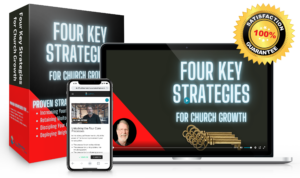This week I want to talk about the multifaceted role of a successful lead pastor in the Post-Covid Church. To begin with, though, I’d like us to get one thing straight: as the lead pastor, you’re the captain of the church ship. Everything from the high seas of worship to the nitty-gritty of budgeting falls under your watch. Everything. To put it as simply and plainly as possible: Pastor, You’re responsible for everything that goes on (and isn’t going on!) in your church. Period!
But here’s the kicker – being responsible for everything doesn’t mean doing everything. It’s about steering the ship, not swabbing the deck.
Every week, you spend a significant portion of your time doing things that you have no business doing. First, there are the ministries, and missions, and tasks that rightfully belong to others in the congregation that somehow you have taken on. Second, there are tasks, and meetings, and even some ministries that have dubious outcomes (if any!), and are wasting significant church resources, including your energy and time. And third, there are those tasks that you have taken on because of tradition or because somebody said, “Pastor, that’s your job,” when in fact those tasks are contrary to the biblical guidelines provided for pastors.
With that said, let’s look at five of the tasks that you cannot delegate, you cannot shirk, and that should take up approximately 100 percent of your time – thus leaving you no absolutely no room for any of the above.
1. Spiritual Modeling: Walking the Talk
First up, spiritual modeling. This isn’t just about ticking off a spiritual checklist; it’s about living out our faith in a way that’s as visible as a city on a hill. Our congregations are watching us, and what they need to see is genuine, lived-out faith. This means our prayer life, Bible study, and interactions should all scream authenticity. We’re not just office-bound shepherds; we’re out there in the community, being Jesus’ hands and feet where everyone can see!
2. Mission Alignment: Keeping the Compass True
Next, we’ve got mission alignment. The church has but one mission and that’s to make disciples. Everything else in the church does is subservient to that Prime Directive. Mission alignment is where we ensure that every church activity is singing in harmony with our mission, vision, and values. If something’s off-key, it’s our job to either tune it up or cut it loose. We’re like orchestra conductors, making sure every note contributes to the symphony of our church’s purpose.
3. Vision Casting: Painting the Big Picture and Inspiring Action
Vision casting is a pivotal role of the lead pastor, but it extends far beyond merely having a vision. It’s about embedding that vision into the hearts and minds of our congregation and community. This involves not just sharing our dreams but igniting a fire of transformation through our preaching. Each sermon we deliver must solve real problems faced by those we’re trying to reach, going beyond education to inspire life transformation. Remember, transformation is driven by action, not just enhanced thinking.
Our preaching should be a catalyst for change, inspiring shifts in behavior, not just in mindset. Every message should be a call to action, challenging our listeners to step out of their comfort zones into a life of active faith. The effectiveness of our preaching is measured not by nods of agreement but by the steps of faith taken by our congregation. Our words should linger, compelling them to make tangible changes in their lives.
Moreover, vision casting is about community involvement. The lead pastor should spend significant time networking in the community, engaging with local leaders, business professionals, and non-profit leaders. This networking should include one-on-one conversations that extend the church’s vision beyond its walls. Time spent with denominational and interdenominational groups, while valuable, should not overshadow the importance of connecting with the broader community.
In essence, vision casting is about keeping the vision alive and vibrant, both within the church and in the wider community. It’s about painting a compelling picture of what could be and inspiring our congregation to turn that vision into reality. Through our preaching and community engagement, we have the opportunity to be the catalysts for spiritual and social transformation.
4. Team Building: Crafting a Dream Team
Moving on to team building. Whether it’s paid staff or volunteer leaders, getting the right people in the right roles is crucial. It’s about fostering a team spirit, where everyone’s pulling in the same direction. Think retreats, open-door policies, and regular check-ins. We’re aiming for a well-oiled machine where everyone knows their part and plays it with gusto.
5. Fund Raising: Fueling the Mission
Last but not least, fund raising. This goes beyond passing the offering plate. It’s about inspiring our congregation with stories of transformation and making those big asks when necessary. We’re talking about significant gifts that can be game-changers for our ministries. These donors need to believe in us, in our vision, and in the impact their generosity can have.
The Missing Pieces: What’s Not on the List
Now, you might be wondering about pastoral care, hospital visits, and all that. Here’s the deal: equipping our church members for these tasks is a key part of our job. Remember the parable of the good shepherd? He leaves the ninety-nine to find the one. That’s our model – reaching out, not just looking in. Need more proof? Check out Ephesians 4:11–13 and take a quick read of the the pastoral response to the Food Pantry Panic in Acts 6.
The Big Picture: More Than Just Tasks
When we embrace these five tasks, we’re not just checking boxes. We’re transforming lives, including our own. We become better spouses, parents, neighbors, and disciples because focus on the important and because we’ve built in some margins. We’re talking about a church that’s not just a building with activities but a vibrant community making a real difference. When you’re not focused on the important, you’ll focus on the irrelevant. And let’s face it, most churches are just marking time while trying to maintain their status quo.
A Word on Balance and Self-Care
Let’s not forget the balancing act. Juggling these tasks requires wisdom and a keen sense of prioritization. It’s about knowing when to delegate and when to dive in. If you can’t discern what belongs to you and what properly belongs to someone else, then it’s easy to start wearing too many hats. To go back to the sailing ship metaphor in the first paragraph, it’s impossible to steer a ship when you’re climbing the masts to untangle a mis-tied rope or sitting in the crow’s nest looking for icebergs. A good captain knows when to work and when to recharge. Self-care for the leader isn’t selfish. It’s essential. A burnt-out pastor can’t light the way for others.
The Ripple Effect: Beyond the Church Walls
Think about the ripple effect. When we excel in these areas, it’s not just our church that benefits. It’s our entire community. We start seeing transformation that goes beyond Sunday mornings. We’re talking about impacting lives, shaping futures, and making a tangible difference in our neighborhoods – and that’s the whole point of the church. It’s not about keeping our members happy, is about turning members into disciples who become neighborhood missionaries and engage one heart at a time.
Embracing Change: The Constant in Ministry
Change is the only constant in ministry. The role of a lead pastor today is vastly different from what it was decades ago. It’s no longer about maintaining the status quo but about driving change, fostering growth, and leading with vision and purpose.
So, let’s rise to the occasion. Let’s embrace these five tasks with passion and dedication. Let’s be the leaders our churches and communities need. And remember, you’re not in this alone. Resources, coaching, and communities of like-minded leaders are just a click away.
Let’s make a difference, one step at a time. Let’s be the transformational leaders we’re called to be.

Need to refocus, get back on track, and grow your church?
Grab your copy of the Four Key Strategies to Sustainable Church Growth video training course. Three videos, three worksheets, four keys to building a foundation for your church’s exponential growth.






[…] be a successful pastor or church leader, you have to be able to understand the needs of your community and personally […]
[…] churches have a natural hierarchy of top-level responsibilities, spearheaded by the lead pastor or ministry leaders. But all believers should be ready and willing to lead, and it starts with […]